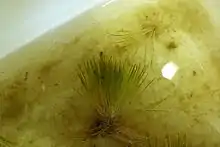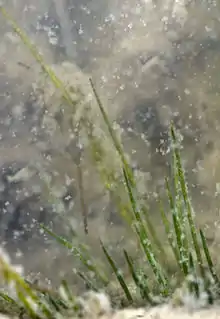Trithuria inconspicua
Trithuria inconspicua is a small aquatic herb of the family Hydatellaceae that is only found in New Zealand.[1][2]
| Trithuria inconspicua | |
|---|---|
 | |
| Trithuria inconspicua collected from a lake bed in Kaipara New Zealand. | |
| Scientific classification | |
| Kingdom: | Plantae |
| Clade: | Tracheophytes |
| Clade: | Angiosperms |
| Order: | Nymphaeales |
| Family: | Hydatellaceae |
| Genus: | Trithuria |
| Species: | T. inconspicua |
| Binomial name | |
| Trithuria inconspicua | |
Description

Trithuria inconspicua is a small (~4 cm) fresh water lily endemic to New Zealand. This lily grows in 5–7 meters of water and is restricted to the fresh water lakes of Northland and Fiordland regions of the North and South Island, respectively. Consisting of multiple 20–40 mm small tussocks and fibrous roots the plant is often partially buried under sediment or algae with only the leaf tips exposed.[3] As the plant is Monoicous individual male and female flowers are found on the same plant, however, in nature plants containing flowers of both sexes are rare.[4] The male flowers consist of bright red 10 mm long filaments, whilst the female flowers are yellow-brown and contain 5-10 styles bunched at the apex.[3]
There are two subspecies, Trithuria inconspicua subsp. inconspicua is found in dune lakes of Northland in the far north of the North Island, and T. inconspicua subsp. brevistyla is found in glacial lakes of the southern South Island (Smissen R.D., Ford K.A. Champion, P.D. and Heenan, P.B., Australian Systematic Botany 32(1): 1-11 (2019). http://www.nzflora.info/factsheet/taxon/Trithuria-inconspicua.html
The first flowering plant?
Based on molecular data from a single plastid gene (rbcL)T. inconspicua was originally believed to a monocot.[5] However, a more recent study using multiple genetic loci, supported by a subsequent re-evaluation of morphological characteristics, now places T. inconspicua as a sister group with the water lilies (Nymphaeales).[6] This new placement of T. inconspicua means only a single lineage of flowering plant is thought to be older, that being the woody New Caledonian shrub Amborella trichopoda.[7]
The predominant view that Amborella represents the oldest flowering plant was recently challenged in a study by Goremykini et al (2013),[8] who showed that when highly variable sites were removed from the dataset, T. inconspicua was consistently identified as the oldest angiosperm lineage. This proposal has attracted criticism from Drew et al (2014), who argued that the basal placement of T. inconspicua is an artifact of the variable site filtering method used by Goremykini et al (2013).[9] One of the main reasons why people are interested in this question is that placing T. inconspicua at the base of the angiosperm lineage would suggest the first angiosperms were soft bodied aquatic plants, rather than a woody terrestrial plants like Amborella. These competing theories have been given the light hearted monikers "wet and wild" and "dark and disturbed".[9][10][11]
Conservation status
Trithuria inconspicua is seriously threatened due to the competition by the introduced bladder wort (Utricularia gibba) as well as other fresh water weeds.
References
- Kew World Checklist of Selected Plant Families
- Dmitry D. Sokoloff, Margarita V. Remizowa, Terry D. Macfarlane, and Paula J. Rudall. 2008. "Classification of the early-divergent angiosperm family Hydatellaceae: one genus instead of two, four new species and sexual dimorphism in dioecious taxa". Taxon 57(1):179-200.
- New Zealand Plant Conservation Network
- Pledge, David H. 1974. "Some Observations on Hydatella Inconspicua (Cheesem.) Cheesem. (Centrolepidaceae)." New Zealand Journal of Botany 12 (4): 559–61.
- Michelangeli, Fabian A., Jerrold I. Davis, and Dennis Wm Stevenson. 2003. "Phylogenetic Relationships among Poaceae and Related Families as Inferred from Morphology, Inversions in the Plastid Genome, and Sequence Data from the Mitochondrial and Plastid Genomes." American Journal of Botany 90 (1): 93–106.
- Saarela, Jeffery M., Hardeep S. Rai, James A. Doyle, Peter K. Endress, Sarah Mathews, Adam D. Marchant, Barbara G. Briggs, and Sean W. Graham. 2007. "Hydatellaceae Identified as a New Branch near the Base of the Angiosperm Phylogenetic Tree." Nature 446 (7133): 312–15.
- Friis, Else Marie, and Peter Crane. 2007. "Botany: New Home for Tiny Aquatics." Nature 446 (7133): 269–70.
- Goremykini, V.V.; Nikiforova, S.V.; Biggs, P.J.; Zhong, B. de Lange, P.; Martin, W.; Woetzel, S.; Atherton, R.A., McLenachan, T.; Lockhart, P.J. 2013: The evolutionary root of flowering plants. Systematic Biology 61 (1) 50–61.
- Drew, Bryan T., Brad R. Ruhfel, Stephen A. Smith, Michael J. Moore, Barbara G. Briggs, Matthew A. Gitzendanner, Pamela S. Soltis, and Douglas E. Soltis. 2014. "Another Look at the Root of the Angiosperms Reveals a Familiar Tale." Systematic Biology 63 (3): 368–82.
- Feild, Taylor S., Nan Crystal Arens, James A. Doyle, Todd E. Dawson, and Michael J. Donoghue. 2004. "Dark and Disturbed: A New Image of Early Angiosperm Ecology." Paleobiology 30 (1): 82–107.
- Coiffard, C., B. Gomez, and F. Thevenard. 2007. "Early Cretaceous Angiosperm Invasion of Western Europe and Major Environmental Changes." Annals of Botany 100 (3): 545–53.